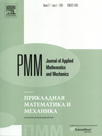 | | Journal of Applied
Mathematics and Mechanics
Russian Academy of Sciences | | Founded
in January 1936
(Translated from 1958)
Issued 6 times a year
ISSN 0021-8928
(print version) |
Archive of Issues
| Total articles in the database: | | 10564 |
| In Russian (ŌŐŐ): | | 9765
|
| In English (J. Appl. Math. Mech.): | | 799 |
|
| << Previous article | Volume 79, Issue 5 / 2015 | Next article >> |
| O.B. Gusíkov, "On the effective viscosity of a dilute suspension of rigid spherical particles," J. Appl. Math. Mech. 79 (5), 453-458 (2015) |
| Year |
2015 |
Volume |
79 |
Issue |
5 |
Pages |
453-458 |
| DOI |
10.1016/j.jappmathmech.2016.03.006 |
| Title |
On the effective viscosity of a dilute suspension of rigid spherical particles |
| Author(s) |
O.B. Gusíkov (Institute of Applied Mechanics of the Russian Academy of Sciences, Moscow, ogskv@mail.ru) |
| Abstract |
The problem of the motion of a spherical bubble of arbitrary size with a specified velocity in a dilute suspension of solid spherical particles is considered in the Stokes approximation for a carrying continuous medium. An expression is obtained for the drag of the bubble in the first approximation in the volume concentration of the dispersed phase. Using the results obtained an expression is derived for the effective viscosity of the suspension, "as seen" by the spherical bubble as it moves through the dispersed medium. It is shown that the coefficient for the volume concentration in the formula for the effective viscosity of the suspension depends on the ratio of the dimensions of the dispersed particles and of the bubble. In the limit, when this ratio approaches zero, the coefficient obtained is identical with Einstein's result for the effective viscosity of the suspension. However, this coefficient may differ considerably from Einstein's result for "non-point" dispersed particles. By comparing this result with the similar result obtained earlier for the case of the motion of a rigid sphere in a viscous suspension it is shown that the coefficient for the volume concentration in the formula for the effective viscosity of the suspension depends not only on the size of the body, but also on the form of the boundary conditions on its surface. |
| Received |
27 November 2014 |
| Link to Fulltext |
|
| << Previous article | Volume 79, Issue 5 / 2015 | Next article >> |
|
 If you find a misprint on a webpage, please help us correct it promptly - just highlight and press Ctrl+Enter If you find a misprint on a webpage, please help us correct it promptly - just highlight and press Ctrl+Enter
|
|

 Russian
Russian  English
English